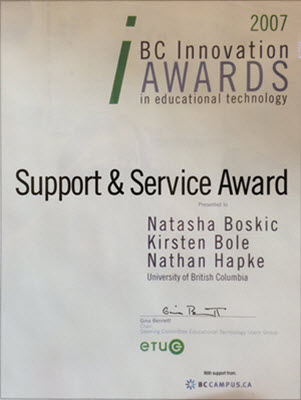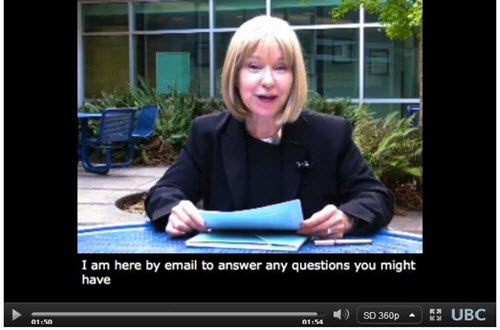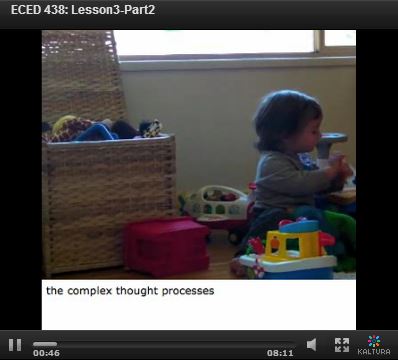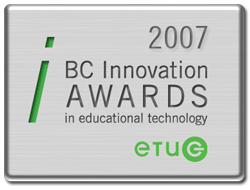Overview
With constant technical IT improvements, the electronic learning environment has become a space that is more and more based on rich media, including audio and video clips, animations and simulations. Many presentations, workshops, and tutorials are done online, usually in real time, and then archived for later review or reference.
We have to keep in mind that disability here does not mean a complete loss of one ability. Most often, people have a combination of impairments with various levels of severity. Online content does not have to be stripped down to a plain text based page to be accessible — it only needs to consider and meet the needs of every learner.
“Accessible Media” was a continuation of the “Web Content Accessibility” project. It focused on developing and redesigning existing media-rich learning resources at UBC, SFU and BCIT, and creating new multimedial content for online courses at both universities (UBC and SFU) and partner institutions (BCIT and SET-BC).
Goals
The main goals of this project were to:
- Use existing media elements (audio and video clips) from existing online course content, and provide alternatives such as transcripts and/or captioning,
- Produce new media elements on demand, while developing new online courses,
- Develop a manual of procedures for creating transcripts and captions.
This improves usability for both disabled and non-disabled learners in the following ways:
- Supporting people with low literacy levels;
- Helping non-native speakers;
- Assisting access for low-bandwidth users.
Deliverables
- Reviewed and updated sections from the existing audio and video material used in online learning content across institutions (Sep – mid-Oct, 2006)
- Digitized content converted from audio cassette or VHS (Mid-Oct – mid-Dec, 2006)
- Produced captions and transcripts (Jan – Aug 31, 2007)
- New media elements (Jan – July 2007)
- A manual of procedures (mid-July – Aug 31, 2007)
Process Manual for Operationalization
A Manual was produced “Accessible Media.”
Workshops on Accessibility (for face-to-face and online delivery)
A number of workshops were developed to accompany the Manual. These workshops were offered from August 21st to August 25th 2006 over the Internet, using Horizon Wimba’s Live Classroom. There were over 25 participants for the five days—mainly from across Canada, but from the USA and other countries as well. A blog was also created to provide a space for sharing additional resources and viewing the workshop PowerPoint slides.
BCCampus Repository, SOL*R
The Manual and the workshop materials are available under a Creative Commons license as part of the BCCampus repository, SOL*R.
Other information related to the project
In addition to the planned activities, the project team decided to participate in various public events. This was intended not only to raise awareness of the importance of accessibility issues, but also to enable those who were already working in an online environment.
- BCEd Online Conference “Connected Learners”, Vancouver (April 19-20, 2006)
- IOP (Investigating Our Practices), UBC (May 6, 2006)
- UBC Learning Conference, UBC (May 11-12, 2006)
- CADE (Canadian Distance Education) Conference, Montreal (May 23-26, 2006)
- BCEd Online Conference, Panel discusion (2007)
- CSUN (Technology and Persons with Disabilities) Conference, Los Angeles (2007)
- ICTA (Information and Communication Technology and Accessibility) Conference, Hammamet, Tunisia (2007)
- NMC (New Media Consortium) Conference, Princeton (June 2008) – Judges Choice Award for the poster
Publications
Boskic, N., Bole, K., Hapke, N., & Kelly, K. (2008). Accessibility and universal design. In E-Learning: Education for a digital world: Advice, guidelines, and effective practices from around the globe. London: Commonwealth of Learning, Part 1. Part 2, Part 3, Part 4, and Part 5.
Boskic, N., & Bole, K. (2007). Talking about people, not technology. Proceedings of the 1st International Conference on Information and Communication Technology and Accessibility. Hammamat, Tunisia.
I don’t have any particular disability, but as an ESL (actually “ETL”) student I really appreciate the transcripts and captions that accompany the audio components. I used to have to replay the audio pieces a couple of times to make sure I had not missed anything, which was a bit frustrating at times.
–Pamela
I find these modifications to be a welcome change to the format. Please continue to use them in this course and others.
–Jennifer




This text will automatically change to the first data-caption value in the list.
Project Team
Project Management
Natasha Boskic, Educational Technology Manager, EPLT
Administration, Code Writing and Web Design
Kirsten Bole (now Starcher), EPLT
Web Development/Programming
Nathan Hapke, Undergraduate Student, Faculty of Education
Consultations
Dr. John Nesbit, Professor, Faculty of Education, Simon Fraser University (SFU)
Mike Bartlett, Provincial Coordinator, Special Education Technology, BC (SET-BC)
Karen Belfer, Instructional Development Consultant, BCIT
